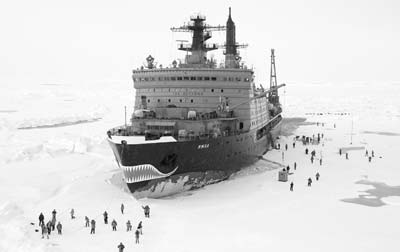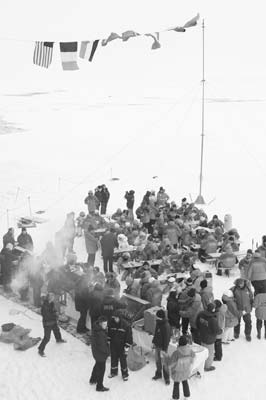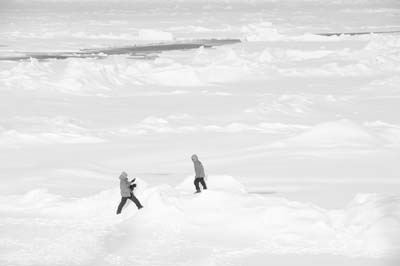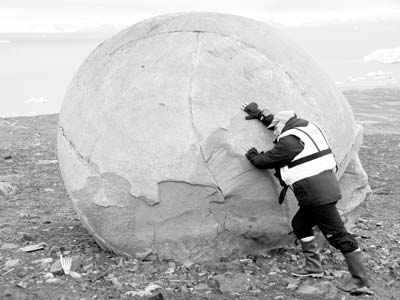The North Pole — an experience like no other
by Gordon Kilgore, Sharpsburg, GA
A trip to the Geographic North Pole is not a trip for everyone. It is not a trip for those on a tight budget. It is not a trip for those who must always have the trappings of civilization within easy reach. However, a trip to one of the most remote areas on our planet most certainly is a unique experience — one that I will never forget.
What to expect
So just what did we find at the North Pole? No, there is no one living there. No, there are no buildings or structures, no huts from earlier expeditions. There is ONLY ice, frozen sea ice that is continually being moved by both the wind and sea currents. Place a stake at 90°N, leave and return back to 90°N after a day or so. Your stake will have moved with the ice.
I was left with an impression of just how vast an area the Arctic North encompasses. For days we saw only ice and broken sea ice. There were not many birds near the Pole, although from time to time birds have been spotted there. We didn’t see any polar bears above about 84°N, although bears have been spotted much farther north.
Our August ’06 trip aboard the nuclear icebreaker Yamal was with Poseidon Arctic Voyages, a Moscow-based company that has been providing trips to the Russian North since 1998.
As promised, a Poseidon representative met us at Sheremetyevo Airport to manage an easy transfer to Hotel Mezhdunarodnaya. Even at the hotel, Poseidon had a hospitality desk to handle any special requests people had.
Our expedition leader was Victor Boyarsky, who is legendary in polar circles. Victor is currently the director of the Russian State Museum of Arctic & Antarctic in St. Petersburg.
To the port
After an excellent breakfast the next morning, we all boarded a bus for a Moscow city tour. For those who had not been to Moscow, this provided a brief introduction to the city’s many attractions. The tour ended at a domestic airport, where our group boarded a charter flight to Murmansk, Russia.
Murmansk is about a 2-hour flight north of Moscow and is situated above the delta of the Tuloma River, approximately 45 kilometers from the Barents Sea. Murmansk is the home of the Russian Northern Fleet and its submarine base. While the Murmansk airport is located some distance from the town, the drive allowed us to appreciate just how wooded this region is.
We were also provided a brief tour of Murmansk. Though the town was founded before the Soviet period, it was during Soviet rule that the town became what it is today. You would be hard-pressed to find a town that has more of a “stamp” of Stalin than Murmansk.
With the city tour completed, we continued to the port. The strictly regimented passport control took some time, but finally our bus was allowed to drive through the huge iron gates into the port and to deliver us to the gangway of the I/B Yamal (I/B stands for “ice breaker”). It appeared much larger than the other icebreakers I have been on.
Each passenger, upon arriving at the top of the gangway, was greeted in the Russian tradition with bread and salt. The crew was very efficient at showing passengers to their assigned cabins.
Getting settled
The majority of the passengers were German and French, followed in number by people from Austria, Italy, Switzerland, Australia, the U.K., Canada, Russia, Japan and the USA. English and Russian were the “universal” languages on board, but interpreters were provided for the Germans and French.
I found the cabins to be better than those I have experienced on other expedition ships. My basic twin cabin had more than ample storage space plus a desk with two chairs — suitable for each person to simultaneously use a laptop or do their writing. All outlets were standard European, 220 volts.
I found the cabin lighting to be adequate for reading or general illumination, not that we needed much light since the sun did not set throughout our trip. If there was a lighting problem, it was the problem of getting the cabin dark enough. The curtains muted the light but were not heavy enough to get the cabin really dark.
The cabin also had a number of hooks attached to the wall on which to hang jackets, waterproof pants, etc. — something I find lacking on the modern cruise ships. Our bathroom had two wall cabinets, a sink, a good shower and an ample number of hangers for towels and clothes.
Each cabin had a speaker to receive announcements pertaining to activities. The staff did an excellent job of keeping passengers informed as to what was going to take place. On our expedition there were 97 passengers, which is almost to capacity. The crew comprised 150 people.
Breaking the ice
The number-one goal of Poseidon Arctic Voyages and the Yamal is to visit the Geographic North Pole, so once the Yamal leaves the port in Murmansk she sets a course north with only one option along the way. That option is making a call at Cape Flora on Northbrook Island or any of the other western islands that make up the Franz Joseph Land archipelago. Should the weather not be suitable for a landing, then it is on to the Pole.
I should mention that all shore landings are by helicopter. The Yamal has a large MI-8 Russian helicopter on board that is capable of easily carrying 20 people. This makes for very fast and efficient landings.
We encountered our first sea ice at latitude 81°N. From that point to the Pole it was a steady job of busting through ice. The early encountered sea ice was not a challenge for the Yamal, but once we reached ice that was greater than three feet thick, the enormous nuclear power of the Yamal was really appreciated.
In open water the Yamal cruised at about 18 knots. Speed was reduced to between eight and 13 knots in broken ice, first year ice and ice that was one meter or less in thickness. Once the ice was continuous or measured six to nine feet thick, the forward speed was reduced to about six or seven knots.
There were a few times when the ice was so thick that the Yamal had to back up and ram it numerous times before penetrating through the multiyear ice. I once counted seven times we had to go back and forward before pushing through. On another occasion, someone else counted 11 times. Now I know why the early explorers failed to reach the Pole.
The North Pole experience
On the fifth day at sea, the Yamal reached 90°N at 23:43 hours. There was a champagne celebration on the bridge, pictures made of the icescape and a feeling of being part of a select group to have actually stood at the North Pole. This select group gets even smaller when you count those who have spent the night at the North Pole. In a few hours, most of the passengers had retired to their cabins for a quiet night’s sleep.
Until you have actually been on an icebreaker, it is hard to comprehend the noise that a ship makes as it plows through solid ice. I had gotten used to the constant noise and did not realize what a difference complete silence was like.
The Yamal found suitable ice nearby so that, the next day, everyone could go down onto the ice to really experience being at the North Pole. The day’s festivities began at mid-morning with short helicopter rides “around the world,” passing through all 24 time zones in a few minutes while affording a look at the ice from the air.
Next, everyone joined hands and walked around the North Pole sign that had been erected on the ice, walking around the world in just a few minutes. The captain gave a short talk, then everyone had time for pictures and to enjoy the ice.
The next activity was the polar plunge. In open water where the Yamal had pushed through the ice, a ladder was attached to the edge of the ice. The few who wanted to dive or jump in the water followed the lead of Victor Boyarsky, our expedition leader. Yes, I did give it a try and, believe me, I have never felt water that cold.
As a safety precaution, a belt was attached to each person’s waist and a rope attached to the belt. The rope was in turn held by a man on the ice. It was not too bad when I first dove in and began to swim. However, within perhaps 15 seconds my body began to shut down. My arms and legs seemed to simply stop working and go numb.
At that point I realized that I had better turn around and head back. It took extra effort to make my arms and legs continue to complete strokes. Quickly climbing out and grabbing a towel, I didn’t find the 23°F air temperature to be so bad, even with a wind blowing at 23 mph. I could easily see why someone who falls into the sea near the Pole has only a few minutes to live.
The water temperature at the Pole was 29.3°F, so it did not take long for the few who wanted to experience the polar plunge to finish. Everyone then enjoyed a barbecue on the ice.
The ship stayed at the Pole until about 15:30 hours, and by that time most everyone had already returned to the ship to warm up.
Franz Joseph Land
Leaving the Pole, we made our way south and slightly east toward Franz Joseph Land. At 83°17'N, 54°05'E we approached a mother polar bear with two cubs.
The Russians and much of Europe call them ice bears, a very appropriate name since these bears are usually found on sea ice hunting seals.
During the expedition we saw a number of bears. Some paid us no attention at all, but others approached the icebreaker for close inspection.
We had numerous landings at Franz Joseph Land. The first landing was at Cape Fligely on Rudolph Island. This cape is the northernmost point of the Eurasian continent. It is also a historically significant site due to the many previous polar expedition disasters, such as those of the Americans Wellman (1899) and Fiala (1904) plus the Italian Stella Polare expedition in 1900. I must say I would hate to have to winter at this rocky, windswept point of land bordered by the sea to the north and glaciers in all other directions.
This location is not far from Teplitz Bay, the site of an abandoned weather station as well as the site of an aircraft wreckage. The wreckage is believed to be that of a Russian Tupolev TB-3 that was part of a 1937 North Pole expedition.
A few more islands
At Cape Norvegia on Jackson Island we made another landing. This spot is famous because it is where Nansen and Johansen spent the winter of 1895-96 in a small hut made of stones and covered with walrus hides.
They were lucky enough to find a Siberian log that had washed ashore which served as a roof support for the hides. More than 100 years later the log and stones are still where they were left, although the hut has been partially filled with dirt and many of the stones have fallen.
Early the next morning the Yamal approached Rubini Rock, on Hooker Island, a cliff with thousands of nesting glaucous gulls and thick-billed murre. The ship approached the rock as close as was safe to allow passengers to observe the organized chaos on the cliff face.
Other landings included one at Cape Tegetthoff on Hall Island — a very pretty landing with nice light illuminating the classic twin peaks at the edge of the sea and the ruins of the Harmsworth House along the point — and one last helicopter landing at Inostrantseva Bay on the high Arctic archipelago of Novaya Zemlya.
Life on board
The Barents Sea was very kind to us as we sailed back to Murmansk. Out on deck, it was obvious that the temperature was getting warmer as we approached the Russian mainland. During our expedition the temperature ranged from about freezing to a low of about 20°F — not bad for the Arctic summer. Wind, or the lack of wind, seemed to make more of a difference than the actual thermometer readings.
Throughout the expedition there were numerous lectures from a variety of experts providing information pertaining to the Arctic. This information gave us a greater appreciation of, and gave more meaning to, many of the landings.
The meals on board the Yamal were far better than I expected. I have had good food on many of my previous expeditions, but Poseidon Arctic Voyages provided food of a higher level. Breakfast was a buffet with a variety of hot and cold cereal, fresh and canned fruits, fish, eggs, sausage, bacon, pancakes and, of course, juices, coffee and tea. Lunch was always buffet style, with salads, fish and fruit plus a couple of hot dishes, or we could order from a choice of entrées as well as soup and dessert.
Dinner included a choice of starters, soups, salads, entrées and desserts, with wine included.
An alarm clock was not needed on board, as 30 minutes before breakfast each morning a wakeup call was announced over the PA system. Mealtimes were also announced, as were all lectures, landings and polar bear sightings.
Planning your trip
Poseidon Arctic Voyages (in London; +44 870 068 8265, www.northpolevoyages.com) has at least two North Pole expeditions planned for August of 2007. Prices for the two weeks in 2006 were $17,800 for a standard cabin, $20,800 for a mini-suite and $23,500 for a suite. This included two nights in a Moscow hotel with breakfast, plus airfare and transfers from Moscow to Murmansk and back. The only expenses that were not included were the visa fee, extra meals in Moscow and round-trip air from home to Moscow.
Communication between the Yamal and shore was available 20 hours a day at a cost of $2 per minute for phone service and $2 per page for e-mail. I found the e-mail service to be very efficient.
A brochure can be downloaded as a PDF file from their website. Poseidon also offers voyages to Franz Josef Land, the Northeast Passage, Kamchatka and the Russian Far East.






